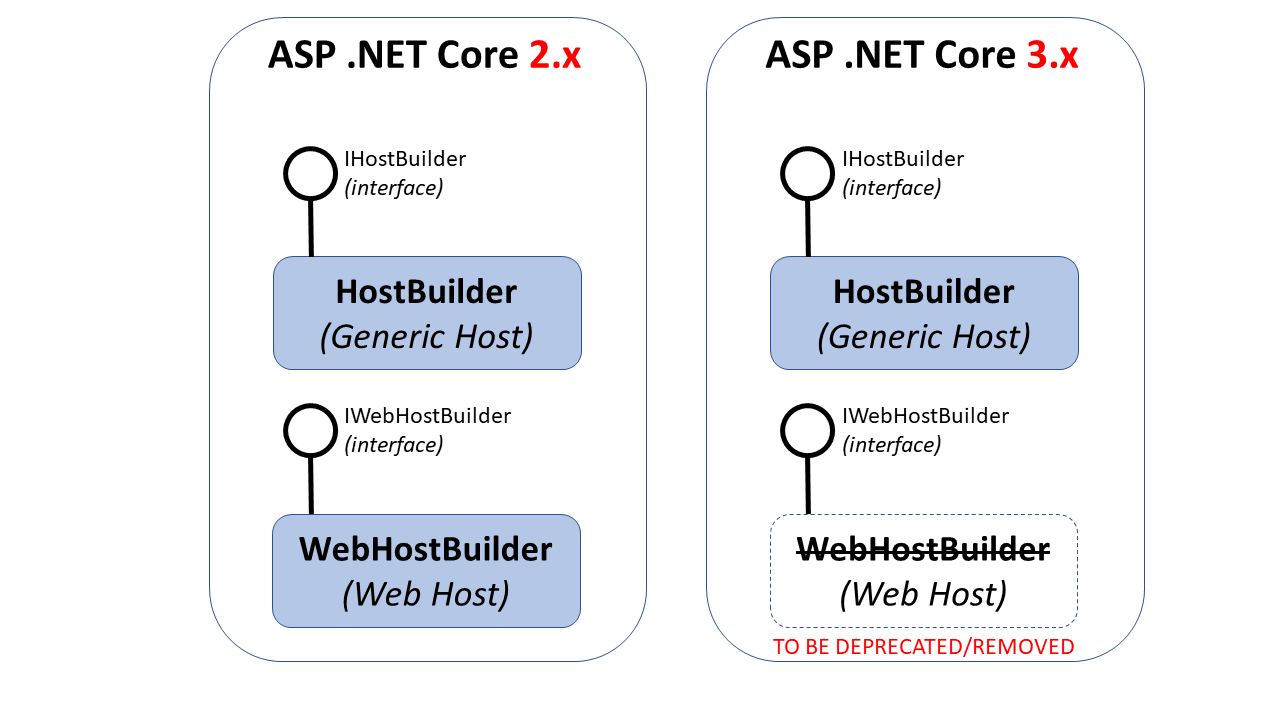This is the seventh of a series of posts on ASP .NET Core in 2019. In this series, we’ll cover 26 topics over a span of 26 weeks from January through June 2019, titled A-Z of ASP .NET Core!
 A – Z of ASP .NET Core!
A – Z of ASP .NET Core!
In this Article:
- G is for Generic Host Builder
- Generic Host Builder in 2.x
- Web Host Builder in 2.x
- Generic Host Builder for Web Apps in 3.x
- References
G is for Generic Host Builder
The Generic Host Builder in ASP .NET Core was introduced in v2.1, but only meant for non-HTTP workloads. However, it is intended to replace the Web Host Builder when v3.0 is released in 2019.
Generic Host Builder in 2.x
So, if the Generic Host Builder isn’t currently used for web hosting in v2.x, what can it be used for? The aforementioned non-HTTP workloads include a number of capabilities according to the documentation, including:
- app config, e.g. set base path, add hostsettings.json, env variables, etc
- dependency injection, e.g. various hosted services
- logging capabilities, e.g. console logging
The HostBuilder class is available from the following namespace, implementing the IHostBuilder interface:
using Microsoft.Extensions.Hosting;
At a minimum, the Main() method of your .NET Core app would look like the following:
public static async Task Main(string[] args)
{
var host = new HostBuilder()
.Build();
await host.RunAsync();
}
Here, the Build() method initializes the host, so (as you may expect) it can only be called once for initialization. Additional options can be configured by calling the ConfigureServices() method before initializing the host with Build().
var host = new HostBuilder()
.ConfigureServices((hostContext, services) =>
{
services.Configure<HostOptions>(option =>
{
// option.SomeProperty = ...
});
})
.Build();
Here, the ConfigureServices() method takes in a HostBuilderContext and an injected collection of IServiceCollection services. The options set in the Configure() can be used to set additional HostOptions. Currently, HostOptions just has one property, i.e. ShutdownTimeout.
You can see more configuration capabilities in the official sample, broken down into the snippets below:
Host Config Snippet:
.ConfigureHostConfiguration(configHost =>
{
configHost.SetBasePath(Directory.GetCurrentDirectory());
configHost.AddJsonFile("hostsettings.json", optional: true);
configHost.AddEnvironmentVariables(prefix: "PREFIX_");
configHost.AddCommandLine(args);
})
App Config Snippet:
.ConfigureAppConfiguration((hostContext, configApp) =>
{
configApp.AddJsonFile("appsettings.json", optional: true);
configApp.AddJsonFile(
$"appsettings.{hostContext.HostingEnvironment.EnvironmentName}.json",
optional: true);
configApp.AddEnvironmentVariables(prefix: "PREFIX_");
configApp.AddCommandLine(args);
})
Dependency Injection Snippet:
.ConfigureServices((hostContext, services) =>
{
services.AddHostedService<LifetimeEventsHostedService>();
services.AddHostedService<TimedHostedService>();
})
Logging Snippet:
.ConfigureLogging((hostContext, configLogging) =>
{
configLogging.AddConsole();
configLogging.AddDebug();
})
Web Host Builder in 2.x
The WebHostBuilder class is available from the following namespace (specific to ASP .NET Core), implementing the IWebHostBuilder interface:
using Microsoft.AspNetCore.Hosting;
The Web Host Builder in ASP .NET Core is currently used for hosting web apps as of v2.x. As mentioned in the previous section, it will be replaced by the Generic Host Builder in v3.0. At a minimum, the Main() method of your ASP .NET Core 2.x web app would look like the following:
public class Program
{
public static void Main(string[] args)
{
CreateWebHostBuilder(args).Build().Run();
}
public static IWebHostBuilder CreateWebHostBuilder(string[] args) =>
WebHost.CreateDefaultBuilder(args)
.UseStartup<Startup>();
}
If you’re not familiar with the shorthand syntax of the helper method CreateWebHostBuilder() shown above, here’s what it would normally look like, expanded:
public static IWebHostBuilder CreateWebHostBuilder(string[] args)
{
return WebHost.CreateDefaultBuilder(args).UseStartup<Startup>();
}
NOTE: This type of C# syntax is known as an Expression Body Definition, introduced for methods in C# 6.0, and additional features in C# 7.0.
The CreateDefaultBuilder() method performs a lot of “magic” behind the scenes, by making use of pre-configured defaults. From the official documentation, here is a summary of the default configuration from the Default Builder:
- use Kestrel as the web server
- configure it using the application’s configuration providers,
- set the ContentRootPath to the result of GetCurrentDirectory(),
- load IConfiguration from ‘appsettings.json’ and ‘appsettings.[EnvironmentName].json’,
- load IConfiguration from User Secrets when EnvironmentName is ‘Development’ using the entry assembly,
- load IConfiguration from environment variables,
- load IConfiguration from supplied command line args,
- configure the ILoggerFactory to log to the console and debug output,
- enable IIS integration (if running behind IIS with the ASP .NET Core Module)
For more information on some of the above, here are some other blog posts in this series, you may find useful:
- Your Web App Secrets in ASP .NET Core
- (Coming soon) IIS In-Process Modules in ASP .NET Core
Generic Host Builder for Web Apps in 3.x
Going forward, ASP .NET Core 3.0 will allow you to use the updated Generic Host Builder instead of the Web Host Builder in your web apps. As of Preview 2, the templates available in ASP .NET Core 3.0 have already been updated to include the Generic Host Builder.
At a minimum, the Main() method of your .NET Core 3.0 web app would now look like the following:
public static void Main(string[] args)
{
CreateHostBuilder(args)
.Build()
.Run();
}
public static IHostBuilder CreateHostBuilder(string[] args) =>
Host.CreateDefaultBuilder(args)
ConfigureWebHostDefaults(webBuilder =>
{
webBuilder.UseStartup<Startup>();
});Here’s an expanded representation of the CreateHostBuilder() method:
public static IHostBuilder CreateHostBuilder(string[] args)
{
return Host.CreateDefaultBuilder(args)
ConfigureWebHostDefaults(webBuilder =>
{
webBuilder.UseStartup<Startup>();
});
}This CreateHostBuilder() method in the 3.0 template looks very similar to the 2.x call to CreateWebHostBuilder() mentioned in the previous section. In fact, the main difference is that the call to WebHost.CreateDefaultBuilder() is replaced by Host.CreateDefaultBuilder(). Using the CreateDefaultBuilder() helper method makes it very easy to switch from v2.x to v3.0.
Another difference is the call to ConfigureWebHostDefaults(). Since the new host builder is a Generic Host Builder, it makes sense that we have to let it know that we intend to configure the default settings for a Web Host. The ConfigureWebHostDefaults() method does just that.
Going forward, it’s important to know the following:
- WebHostBuilder will be deprecated and then removed in the near future
- However, the IWebHostBuilder interface will remain
- You won’t be able to inject just any service into the Startup class…
- … instead, you have IHostingEnvironment and IConfiguration
If you’re wondering about the reason for the limitation for injecting services, this change prevents you from injecting services into the Startup class before ConfigureServices() gets called.
References
- ASP.NET Core updates in .NET Core 3.0 Preview 2: https://blogs.msdn.microsoft.com/webdev/2019/01/29/aspnet-core-3-preview-2/
- .NET Generic Host: https://docs.microsoft.com/en-us/aspnet/core/fundamentals/host/generic-host?view=aspnetcore-2.2
- ASP.NET Core Web Host: https://docs.microsoft.com/en-us/aspnet/core/fundamentals/host/web-host?view=aspnetcore-2.2
- Using HostBuilder and the Generic Host in .NET Core Microservices: https://www.stevejgordon.co.uk/using-generic-host-in-dotnet-core-console-based-microservices
- The ASP.NET Core Generic Host: namespace clashes and extension methods: https://andrewlock.net/the-asp-net-core-generic-host-namespace-clashes-and-extension-methods/
- Samples on GitHub: https://github.com/aspnet/Docs/tree/master/aspnetcore/fundamentals/host/generic-host/samples/

Pingback: Dew Drop – February 19, 2019 (#2902) | Morning Dew
Pingback: Handling Errors in ASP .NET Core | Wake Up And Code!
Pingback: Key Vault for ASP .NET Core Web Apps | Wake Up And Code!
Pingback: Logging in ASP .NET Core | Wake Up And Code!
Pingback: Worker Service in ASP .NET Core | Wake Up And Code!
Pingback: Logging dans .Net Core | Nouvelles Chroniques d'Amethyste
Pingback: Key Vault for ASP .NET Core 3.1 Web Apps | Wake Up And Code!
Pingback: Handling Errors in ASP .NET Core 3.1 | Wake Up And Code!